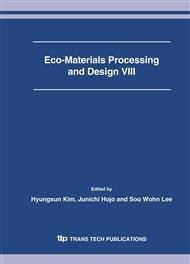p.487
p.491
p.495
p.499
p.503
p.507
p.511
p.517
p.521
A Study of Alternative Construction Materials for Slag Derived from Steel Making Industry
Abstract:
The present study examined the effect of the activation properties of granulated blast furnace slag according to the type of alkaline activator, the specific surface area of blast furnace slag, and the amount of ordinary Portland cement substituted on the compressive strength of the cement containing blast furnace slag. For activators, Na2SiO3, Na2CO3, NaOH, and Na2SO4 were used. Na2SiO3, Na2CO3, and Na2SO4 were converted into Na2O, to which 1 wt.%, 3 wt.%, 5 wt.%, and 7 wt.% were added, and subjected to experimentation, with the W/S (water/solid) ratio = 0.5. The principal hydration products were C-S-H, C4AH13, Aft (ettringite), and Al(OH)3. Na2CO3 exhibited the largest slag hydration rate. Consequently, the present study used Na2CO3 as the alkaline activator. The compressive strength of blast furnace slag cement mortar was then measured according to the amount of Na2CO3 added (2.5 wt.% and 5.0 wt.%), the specific surface area of blast furnace slag (4,000 cm2/g, 6,000 cm2/g, and 8,000 cm2/g), and the substitution rate (30 wt.%, 50 wt.%, and 70 wt.%) of the blast furnace slag in terms of ordinary Portland cement. The results are as follows: at the ages of 1 day and 3 days, respectively, the early strength increased as the specific surface area of blast furnace slag and the amount of alkaline activator added increased; at the age of 7 or more days, the compressive strength increased as the amount of alkaline activator added decreased and as the specific surface area of blast furnace slag increased.
Info:
Periodical:
Pages:
503-506
Citation:
Online since:
May 2007
Authors:
Keywords:
Price:
Сopyright:
© 2007 Trans Tech Publications Ltd. All Rights Reserved
Share:
Citation:


